How does the OSHA calculate it’s Touch Potential Safety Threshold?
OSHA (Occupational Safety & Health Association) – part of the United States Department of Labor - ensures safe and healthy working conditions for workers by enforcing standards and by providing training, outreach and assistance.
 What is the OSHA?
What is the OSHA?
The Occupational Safety & Health Association (OSHA) – is part of the United States Department of Labor and is to ensure safe and healthful working conditions for workers by setting and enforcing standards and by providing training, outreach and assistance. The OSHA sets Electrical Safety Guidelines that are used by most of the US.
What safety guidelines are issued by the OSHA?
OSHA 1910 Occupational Safety and Health Standards – are a range of standards covering safety concerns across many industries, with subparts that focus of specific areas of work.
OSHA 1910.269 Electric Power Generation Transmission and Distribution - is a Guideline that sets out procedures for safe working around Electrical Hazards.
What safety voltage threshold does the OSHA set?
OSHA 1910.269(I)(1)(ii) (page 21) – States 50Vac as a safety threshold -“Only qualified employees may work in areas containing unguarded, uninsulated energised lines or parts of equipment operating at 50 volts or more”.
OSHA 1910.269(I)(3)(i) (page 21) – The employer shall establish minimum approach distances no less than the distances computed by table R-3 (Fig1) for AC systems or Table R-8 for DC Systems.
In (Fig1) Table R-3 for AC Voltages, the Thresholds start at 50Vac and the advice is to ‘Avoid Contact’ with voltages above 50Vac.
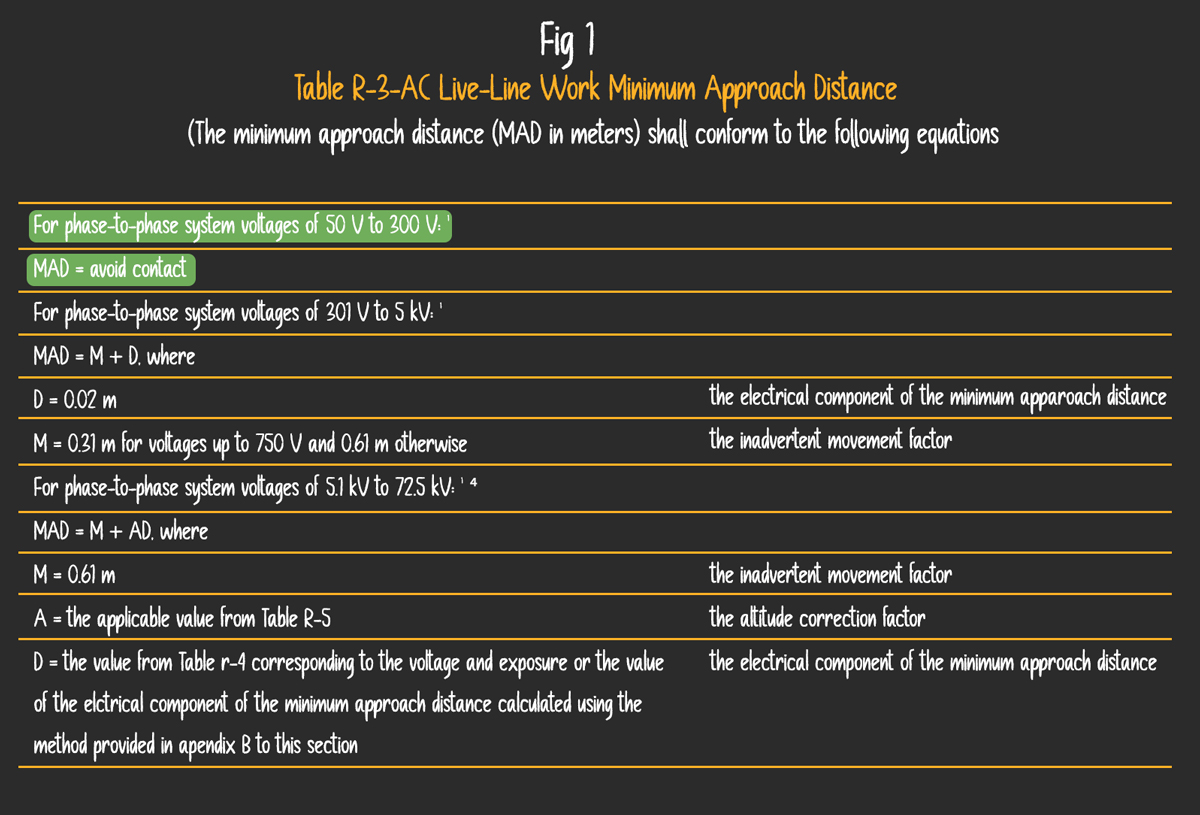
How does the OSHA calculate its Safety Threshold?
OSHA 1910.269 Appendix C – Protection from Hazardous Differences in Electric Potential provides guidelines on how an employer can determine whether any differences in electric potential to which workers could be exposed are hazardous as part of the demonstration required by OSHA 1910.269 (n).
It goes on to quote Dalziel’s Formula (Fig 2) for determining the threshold of ventricular fibrillation when the duration of the electric shock is limited:
Where I is the current through the worker's body in milliamps, and t is the duration of the current in seconds. This equation represents the ventricular fibrillation threshold for 95.5 percent of the adult population with a mass of 50 kilograms (110 pounds) or more. The equation is valid for current durations between 0.0083 to 3.0 seconds.
To use this equation for setting a safe voltage, the employer will need to assume a value for the resistance of the worker's body. The OSHA guideline references the IEEE Std 1048-2003 standard stating that "total body resistance is usually taken as 1000 Ω for determining body current limits."
OSHA 1910.269 Appendix C goes on to say that “the equation above can only be used if precautions are in place to protect workers from hazards associated with involuntary reactions that is to say from currents as low as 1milliamp, the recognised threshold of perception and 6 milliamps, the recognised ‘let go’ threshold.”
Who are the IEEE and what is standard IEE 1048-2003?
IEEE (Institute of Electrical and Electronic Engineers) – is a professional association for electronic and electrical engineering (and associated disciplines) with its head office in New York City. It was formed in 1963 from the amalgamation of the American Institute of Electrical Engineers and the Institute of Radio Engineers. Its objectives are the educational and technical advancement of electrical and electronic engineering, telecommunications, computer engineering and similar disciplines. The IEEE has 423,000 members in over 160 countries.
When it comes to calculating Safety Voltages and stating values for Current Thresholds and Body Resistance, OSHA 1910.269 refers to Standard 1048-2003 which is the Guide for Protective Grounding of Power Lines that was published by the IEEE.
IEE 1048-2003 Standard – Guide for Protective Grounding of Power Lines
This document provides guidance to install protective grounding for the purpose of minimising the risk of contact with surfaces that may present a danger of electric shock. The document also states Current Thresholds and values of Body Resistance and how to use them with Dalziel’s Formula to calculate Voltage Safety Thresholds.
IEE 1048-2003 (Fig3) – Reaction to Power Frequency Currents – the table below recognises various Current levels that cause physiological reactions such as Startle Reaction and Ventricular Fibrillation.”

IEE 1048-2003 – Page 8 also show’s Dalzeil’s formula (Fig1) for calculating a safe current threshold but as well as stating a constant of 116, this document also says the following “The constant, 157, is used for a utility worker weighing not less than 70 kg. Although this relationship may be modified in the coming years, it is a well-established one. The formula gives a current limit for assessing the safety of electrical systems, where it is generally the touch voltage that is calculated. To determine the safe touch voltage, select the resistance of the person and the associated clothing, footwear, and grounding equipment.”
IEE 1048-2003 – Page 8 (Fig4) goes on to show how the body’s resistance can be calculated and used to determine a safe touch voltage and states “The human body has two series resistances: the internal body resistance and the skin resistance. The total body resistance is usually taken as 1000 Ω for determining the body current limits”.
.jpg)
IEE 1048-2003 – Page 8 (Fig5) shows typical values for body resistance and quotes Dalziel as its source for that data.

We can see that both the OSHA and IEEE quote Dalziel for values of Body Resistance and Current Physiological Reaction Thresholds and use his Formula to Calculate Safety Thresholds but, who is Dalziel and how did he calculate those values?
Who is Dalziel and how were his Current Thresholds calculated?
Charles Dalziel (1904–1986) was a professor of electrical engineering and computer sciences at the University of California in Berkley. In the late 1940s and early 1950s he researched the affects of electrical current on the human body, carrying out experiments on volunteers and documenting the results in his paper “Effects of Electric Shock on Man” published in 1956. Dalziel’s research culminated in his formula to calculate s safe Current Threshold to protect against Ventricular Fibrillation known as Dalziel’s Formula.
Effects of Electric Shock on Man – Charles Dalziel (1956)
In the introduction to this paper, Dalziel explains that the purpose of his research is to better understand the effects of electrical current on human beings and says “it is a starting point at which to incorporate safety into the design of electrical equipment. This knowledge is essential in explaining and justifying safety regulations, safe work procedures, and rescue and resuscitation methods for electric shock victims.”
We can see in the picture below, one of 115 subjects in the process of determining a ‘threshold of perception’ by holding 2 wires on the tip of his tongue as this was found to be the most sensitive part of the body.
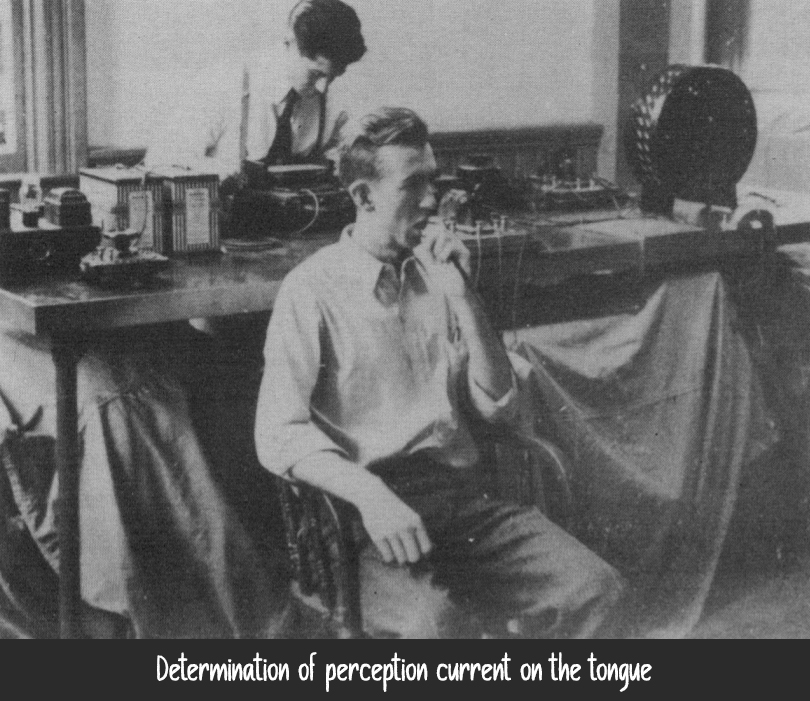
Below are two pictures of subjects with wires in their hands that are being tested to determine perception currents on the hands.
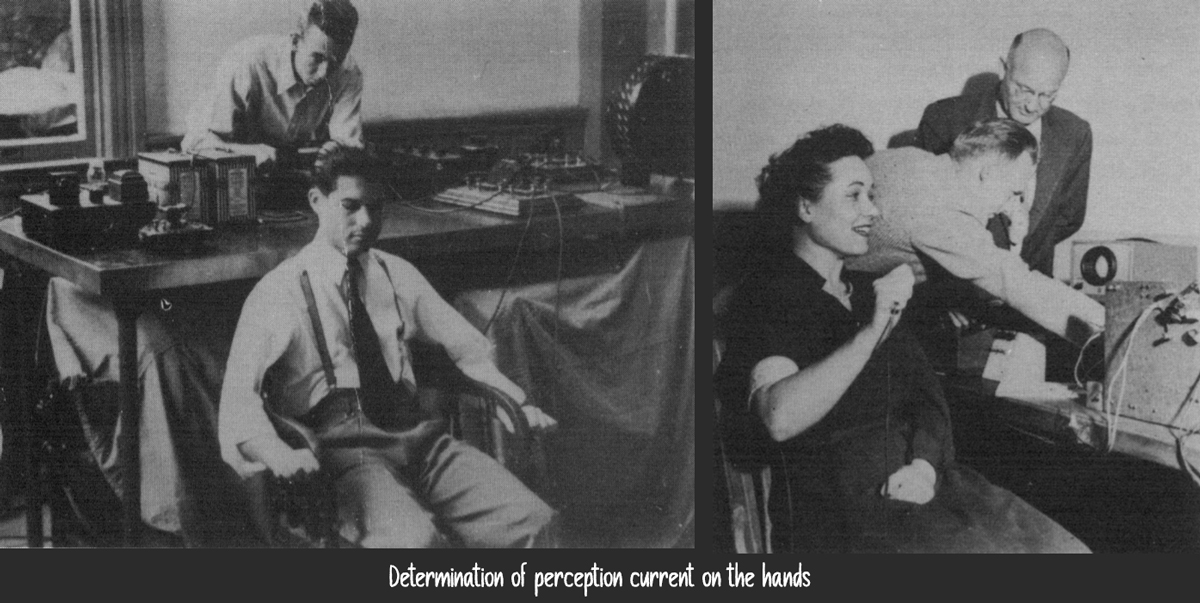
Below is an image of a subject being tested to determine a threshold for the ‘let go current’.
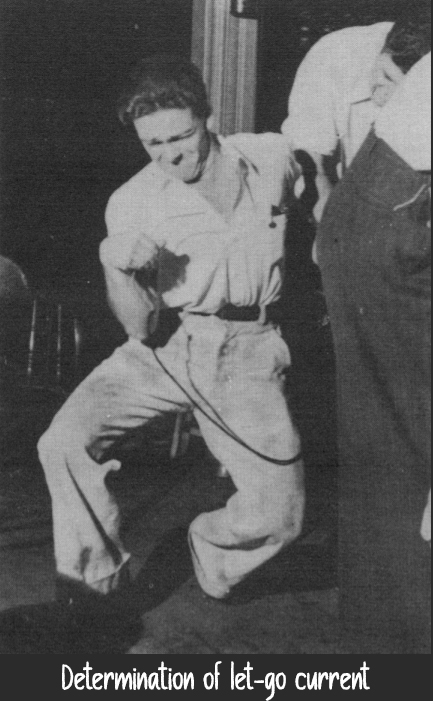
As test currents became higher and closer to a threshold that would cause serious injury or heart fibrillation then the human subjects were replaced by animals. Dalziel used studies that were carried out jointly by Columbia University and Bell Telephone Laboratories, on sheep, calves, pigs and dogs, whose dimensions, weights and heart rates were comparable to man.
The results of these studies on heart fibrillation are plotted in the graph below.
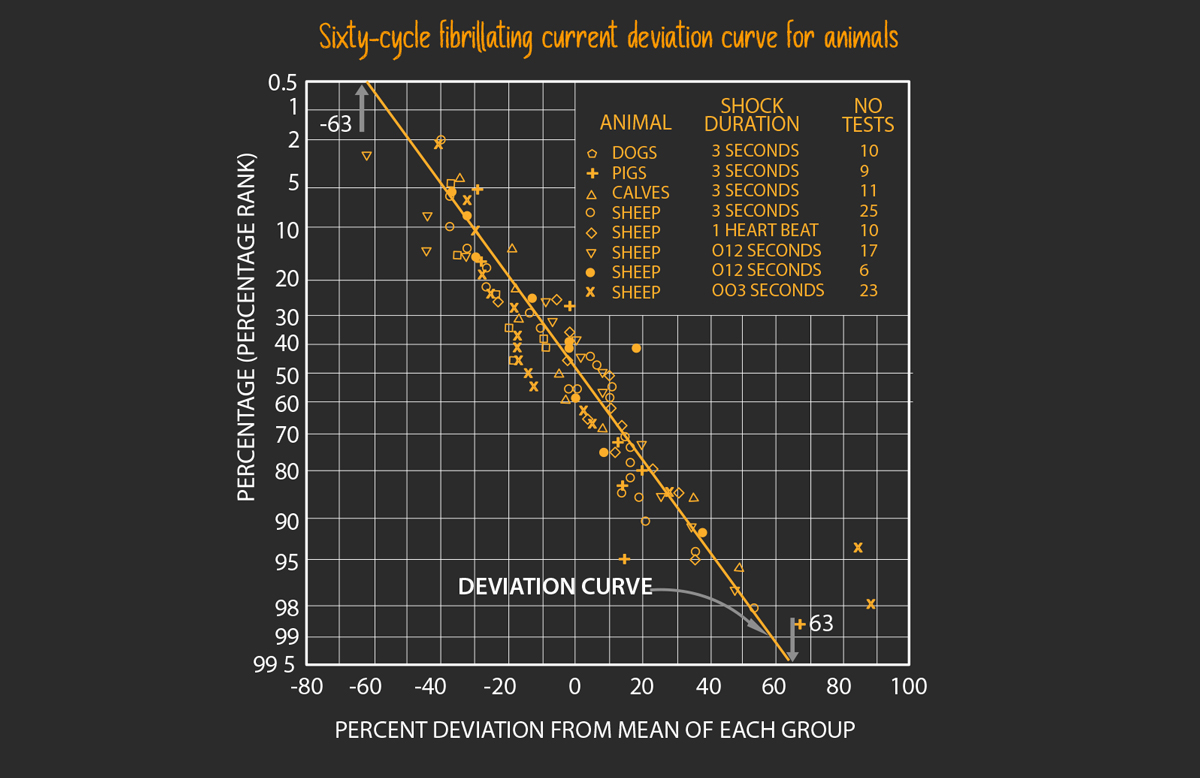
In the graph below, Dalziel went on to use this data to create the following graph that plots fibrillation current against the duration of shock. The cross-hatched area between the two parallel lines C and D represents the probable minimum fibrillation threshold for all 70 kg mammals including man.
.jpg)
The results of Dalziel’s experiments and reports are summarised in the table below.
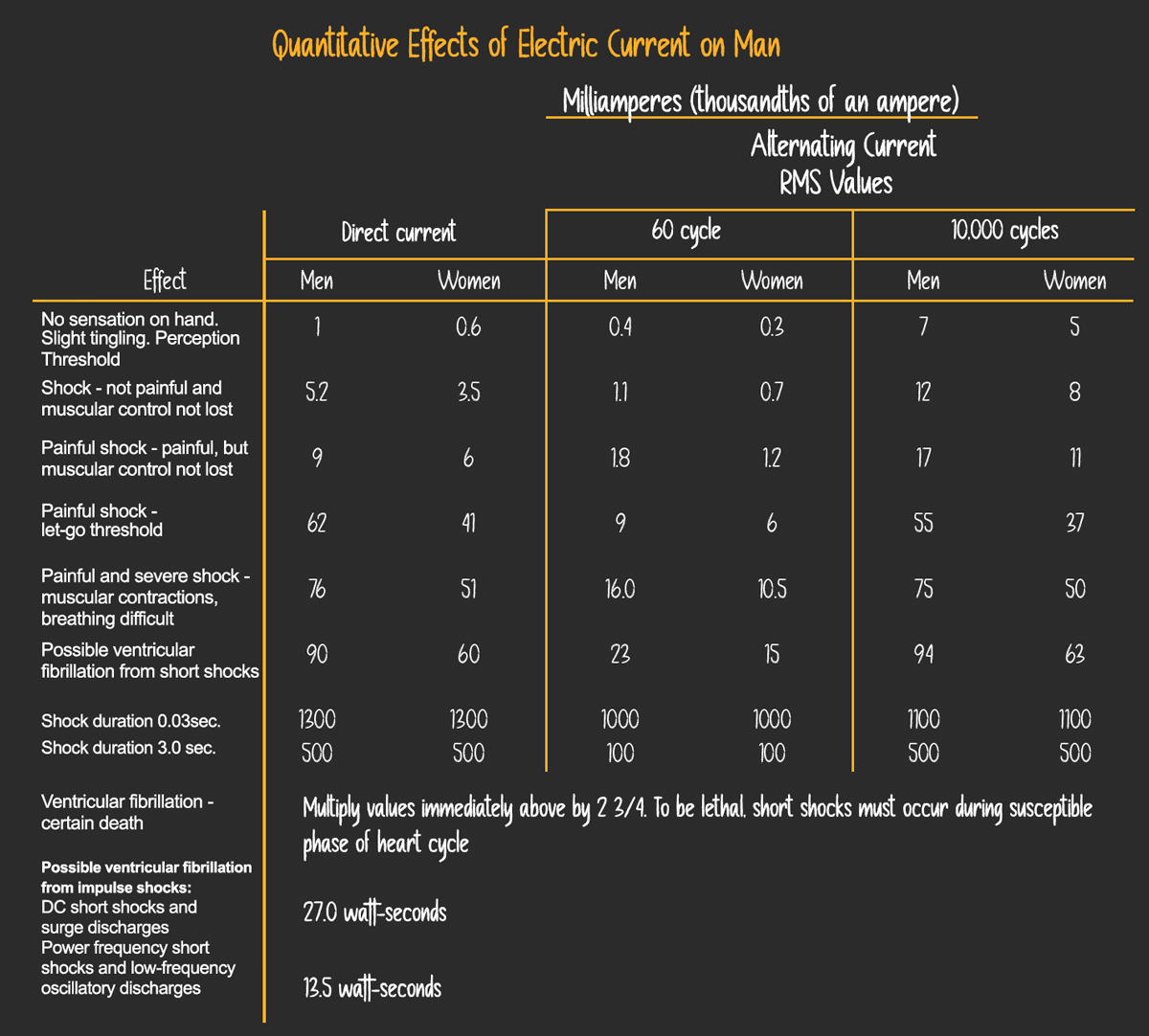
Dalziel went on to use these results from the above 2 tables for the calculation that would be become Dalziel’s Formula and is used by the OSHA and IEEE to calculate their Threshold for Heart Fibrillation.
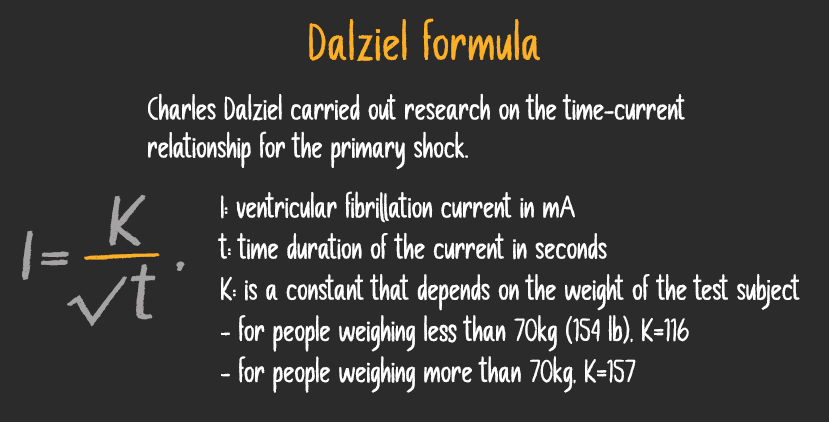
Conclusion
We can see that the OSHA’s use of Dalziel’s formula to calculate Voltage Safety Thresholds is supported by extensive research from Charles Dalziel which has been evaluated by the IEEE (Institute of Electrical and Electronic Engineers) and summarised in it’s IEE 1048-2003 Standard – Guide for Protective Grounding of Power Lines.
Find out more about safe voltage detection:









